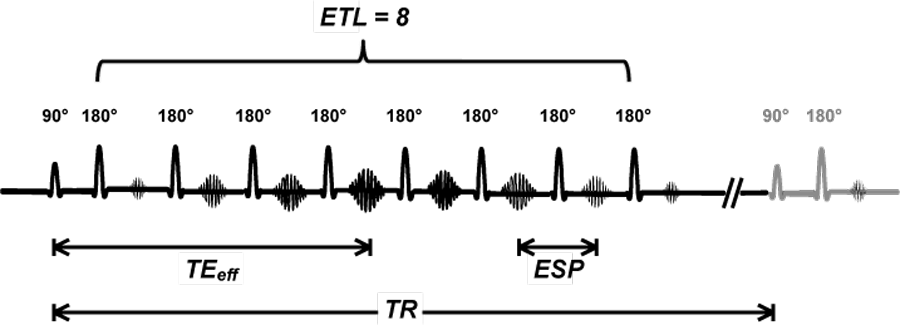In conventional spin-echo (CSE) imaging, only two basic timing parameters are required to be specified, repetition time (TR) and echo time (TE). In fast/turbo spin echo (FSE/TSE) imaging, simple TE is replaced by effective echo time (TEeff), the time at which the central lines of k-space are being filled. Additionally, two new parameters are needed:
- Number of echoes -- called echo train length (ETL) by GE and Canon; turbo factor by Siemens and Philips; or shot factor by Hitachi.
- Time between echoes -- called echo spacing (ESP) by GE, Philips, Siemens, and Canon; interecho time (ITE) by Hitachi.
 Increased T2 weighting with increasing ETL.
Increased T2 weighting with increasing ETL.All images TR=4000 and other parameters unchanged
Echo train length (ETL) is the single most important parameter. In general, image acquisition time is inversely proportional to ETL. In other words, if a CSE sequence with a certain TR/TE/spatial resolution takes 8 minutes to perform, a FSE sequence with ETL=8 would take only 1 minute.
ETL also has important effects on image quality. Longer ETLs result in more T2-weighting because more late echoes with longer TE's contribute to the overall signal.
Longer ETL's are also associated with a decrease in overall signal-to-noise ratio (SNR) and contrast-to-noise ratio (CNR) because the later echoes are weaker.
The use of later echoes at very long TE's also produces more spatial blurring. This spatial blurring effect results from T2-related signal loss on late echoes; recall that these echoes are obtained with higher-order phase encodings corresponding to high spatial frequencies and details in the image.
ETL also has important effects on image quality. Longer ETLs result in more T2-weighting because more late echoes with longer TE's contribute to the overall signal.
Longer ETL's are also associated with a decrease in overall signal-to-noise ratio (SNR) and contrast-to-noise ratio (CNR) because the later echoes are weaker.
The use of later echoes at very long TE's also produces more spatial blurring. This spatial blurring effect results from T2-related signal loss on late echoes; recall that these echoes are obtained with higher-order phase encodings corresponding to high spatial frequencies and details in the image.
The number of slices required to cover an anatomical region in a given TR interval should also be considered in selection of ETL. In conventional two-dimensional Fourier transform (2DFT) SE imaging, recall that the "dead time" at the end of each TR interval is not wasted; this time is used to excite other slices in the multislice acquisition (see this prior Q&A if you need a review). A tradeoff exists in FSE imaging between the ETL and the number allowed slices for a given TR. If the ETL is too large, two separate FSE acquisitions (with double the imaging time) may be required to encompass the required number of sections.
Increasing echo spacing (ESP) permits the use of longer TE's but adversely impacts SNR and CNR. Motion, susceptibility, and edge-related artifacts increase. In general, increased ESP has predominantly deleterious consequences on image quality; the shortest permitted ESP should therefore be chosen in most applications.
Image contrast can be made to resemble that of a conventional SE technique by clustering the collection of low-order phase-encoding steps near the TE value desired. This may be done because global image contrast is determined principally from signals acquired at the low-order phase-encoding steps at the center of k-space (the high-order steps contribute mostly to edge detail at the periphery of k-space). Therefore, although each echo in a train has been acquired with a different TE, the effective TE dictating overall image contrast is determined by the TE at which the low-order steps were performed. This is generally chosen to be in the middle of the train of echoes, but may be moved to the front or the end of the series in special applications.
Advanced Discussion (show/hide)»
No supplementary material yet. Check back soon!
References
Constable RT, Smith RC, Gore JC. Signal-to-noise and contrast in fast spin echo (FSE) and inversion recovery FSE imaging. J Comput Assist Tomogr 1992; 16:41-47.
Li T, Mirowitz SA. Fast T2-weighted MR imaging: impact of variation in pulse sequence parameters on image quality and artifacts. Mag Reson Imaging 2003;21:745-753.
Sze G, Kawamura Y, Negishi C, et al. Fast spin-echo MR imaging of the cervical spine: influence of echo train length and echo spacing on image contrast and quality. AJNR Am J Neuroradiol 1993; 14:1203-13.
Constable RT, Smith RC, Gore JC. Signal-to-noise and contrast in fast spin echo (FSE) and inversion recovery FSE imaging. J Comput Assist Tomogr 1992; 16:41-47.
Li T, Mirowitz SA. Fast T2-weighted MR imaging: impact of variation in pulse sequence parameters on image quality and artifacts. Mag Reson Imaging 2003;21:745-753.
Sze G, Kawamura Y, Negishi C, et al. Fast spin-echo MR imaging of the cervical spine: influence of echo train length and echo spacing on image contrast and quality. AJNR Am J Neuroradiol 1993; 14:1203-13.
Related Questions
What is Fast (Turbo) spin echo imaging?
What is Fast (Turbo) spin echo imaging?

